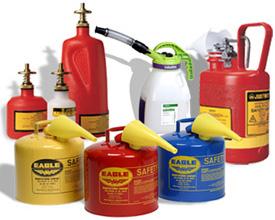 Safety cans are used to store dangerous and flammable chemicals, such as gasoline, kerosene and diesel fuel. They are specifically designed to ensure that these materials are kept safe and handled property to reduce the risk of fire or explosion.
Safety cans are used to store dangerous and flammable chemicals, such as gasoline, kerosene and diesel fuel. They are specifically designed to ensure that these materials are kept safe and handled property to reduce the risk of fire or explosion.
Safety cans include a number of features that make them the preferred choice of Underwriters Laboratories for carrying, dispensing and storing gasoline and other flammables in quantities up to five gallons. These include a brass pour spot and a spring-loaded cap with neoprene gasket that closes the spout automatically when released. Tension in the spring forced the cap closed and provides a leak-proof seal.
Special Design Features Reduce Risk
The spring tension also is designed to lift the cap slightly whenever there is a buildup of excessive vapor pressure inside the can. This feature automatically allows vapors to vent whenever pressure exceeds five PSI. This prevents the can from rupturing or exploding if it is exposed to excessive outside heat.
Spouts on safety cans also are equipped with a flame arrester screen that prevents outside fire from reaching the flammable liquid inside the can. This is the same type of screen found in marine gasoline engine carburetors. When the screen is in place, in the event of a fire the vapors will burn around the spout, but will not allow the flame to enter the can.
Color Coded for Product Identification
Most safety cans are made of 24-guage galvanized steel and feature two-piece, no-weld construction without top or side seams. Safety cans are color coded so that their contents can be immediately identified. Red cans are for flammables such as gasoline. Blue cans are for kerosene. And yellow cans are for diesel fuel.
Safety cans should only be stored in well-ventilated areas. They should never be placed in a trunk of a vehicle, for example, because if the trunk heats up from the sun, the contents of the can may expand, building vapor pressure and raising the spring cap. This may allow vapors to escape the can and build up in the trunk, which can potentially cause an explosion.
Safety Cans Allow You to Put Safety First
The improper use of safety cans can cause serious injuries, such as first degree burns, or even fatalities. Although previously the US Occupational Safety and Health Administration required that combustible liquids be stored only in approved metal containers, the agency recently revised its rule on safety cans (1926.152(a)(1)) allowing the use of plastic safety cans that have received approval by the US Department of Transportation. Plastic cans aren’t required to be equipped with a spring closing lid, spout cover or flash arresting screen.
Bahrns carries a complete line of UL-approved safety cans caddies, as well as other equipment for safely storing potentially hazardous materials.
